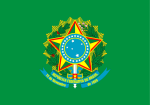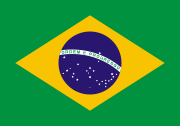Juscelino Kubitschek
| Juscelino Kubitschek de Oliveira | |
 |
|
|
21st President of Brazil
|
|
|---|---|
| In office January 31, 1956 – January 31, 1961 |
|
| Vice President | João Goulart |
| Preceded by | Nereu Ramos |
| Succeeded by | Jânio Quadros |
|
|
|
| Born | September 12, 1902 Diamantina, Minas Gerais |
| Died | August 22, 1976 (aged 73) Resende, Rio de Janeiro |
| Nationality | Brazilian |
| Political party | Social Democratic Party - PSD |
| Spouse(s) | Sarah Kubitschek |
| Profession | Doctor |
| Signature | |
Juscelino Kubitschek de Oliveira (JK) (September 12, 1902 – August 22, 1976) was a prominent Brazilian politician who was President of Brazil from 1956 to 1961. He was born in Diamantina, Minas Gerais, and died in 1976. His term was marked by relative economic prosperity and political stability, being most known by the construction of a new capital, Brasília.
Contents |
Life

Kubitschek was born into a very poor family in the countryside of Brazilian state Minas Gerais.[1] His father, João César de Oliveira (1872-1905), who died when Juscelino was two years old, was a traveling salesman. He was raised by his mother, a schoolteacher named Júlia Kubitschek (née Kubíček; 1873-1971), of Czech descent.[2].
Trained as a medical doctor, Kubitschek was elected to the Chamber of Deputies of Brazil from his home state in 1934. With the imposition of Getúlio Vargas' dictatorship in 1937, Kubitschek returned to practicing medicine. However, he was soon appointed mayor of Belo Horizonte in 1940. There, he idealized the project of an artificial lake (Pampulha Lake) to supply water to the city and also an architectural complex, with several buildings projected by renowned architect Oscar Niemeyer.
He was again elected to the National Congress of Brazil in 1945, and became governor of the state in 1950. In 1955, he ran for president with the slogan "Fifty years of progress in five", and won.
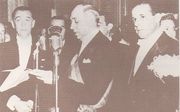
He was sworn in on January 31, 1956 as President of what was then known as the Republic of the United States of Brazil.
Presidency
Kubitschek's presidency was marked by a time of political optimism. He launched the "Plan of National Development", also known as the "Plano de metas (Goal's plan)", famous by the motto: "Fifty years of progress in five". The plan had 31 goals distributed in six large groups: energy, transports, food, base industries, education and the main goal, the construction of Brasilia. This plan searched to stimulate the diversification and expansion of the Brazilian economy, based on the industrial expansion and the integration of the national territory.
Guarantor of democracy
His government was marked by a time of political stability and maintenance of the democratic regime. Kubitschek used his outstanding political ability to reconciliate Brazilian society. He avoided any direct clash with his political adversaries, like the UDN, the main opposition party of the Kubitschek administration. He also gave political amnesty to the men that took part in the Jacareanga and Aragarças military revolts.
Economy and major works
Although his main project was to develop the national industry, it was with the "Goal's plan", launched in 1956, that there was a greater opening of the national economy for the foreign capital.He exempted from taxes all the machines and industrial equipments imports, as well as to the foreign capital. However, the exemption was only made if the foreign capital was associated with the national capital ("associated capital"). To ampliate the internal market, he offered a generous credit policy.
He promoted the implantation of the automobilistic industry, with the coming of the automobile industries to Brazil, promoted the naval industry and the heavy industry, and the construction of hydro-electric power stations. With the exception of the hydro-electrical companies, Juscelino practically created no state owned companies.
Kubitschek also cared a lot for the construction of the great trans-regional roads. He was criticized for only focusing in road construction and putting aside the rail transportation. 'Till today , this decision is still polemical. Still, the construction of the roads helped the integration of the Amazonic region, together with the construction of Brasilia.
The economy boomed, but at some cost. His opponents alleged that he had brought "fifty years of inflation in five." Like many other Latin American currencies, the cruzeiro was repeatedly devalued. The country also went further into debt trying to pay for various ambitious projects, although such debts were very small compared to the tremendous rise of the external debt during the military dictatorship (1964-1985).
By the end of his term, the foreign debt had grown 1.5 billion dollars larger, getting to 3.8 billion dollars in the whole. The inflation and wealth inequality had grown larger, with the occurrence of strikes in the rural zone that expanded to the urban areas. However, the minimum wage from that time is still considered tha largest in any moment of the Brazilian history.
Kubitschek ended his time in office with a growth of 80% in industrial production but with an inflation rate of 43%.
The construction of Brasília
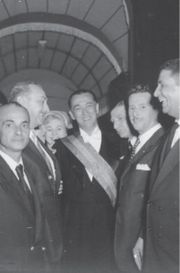
The idea of building a new capital in the center of the country was already idealized in the Brazilian constitution of 1891, 1934 and 1946, however, it was only in 1956 that the construction began to take form
The works, led by the architects Lucio Costa and Oscar Niemeyer, started in the month of February 1957. More than 200 machines were put to work and 30.000 workers came from every part of the country, especially the northeast. The construction went on day and night, with the objective of finishing Brasília by 21 of April 1960, in a homage to the Inconfidência Mineira. The building was finished in 41 months, before the established date. As soon as it was inaugurated, Brasília was considered a masterpiece of modern urbanism and architecture
The New capital was to integrate all the Brazilian regions, create jobs and absorbe workforce from the Brazilian Northeast and to stimulate the economy of the Central-west and North.
Corruption
Kubitschek was not free from controversies. He was often accused of corruption. The accusation began at the time he was governor and intensified during his presidency. The building of Brasília was the main source of accusations. There were serious reasons to believe that people from Juscelino's political group had been favoured in the construction. Also, the Brazilian Pan-Air had the monopoly of people and goods transportation during the construction, another source of controversy.
During his office, the Brazilian press even said that he had the seventh greatest fortune in the world, a claim that was never proved. The candidate for the next presidency, Janio Quadros, used the accusations during his presidential campaign, promising to "sweep the corruption out of the country". Later, during the military regime, Juscelino would be questioned about the corruption allegations and about supposed ties with communist groups
Kubitschek was succeeded by Jânio Quadros in 1961. After the military took power in 1964, Kubitschek's political rights were suspended for 10 years. He went into self-imposed exile and stayed in numerous U.S. and European cities.
The "Golden Years"
Despite all the problems, Kubitschek's presidency was seen as a time of optimism. The president was a cheerful and charismatic figure that exhaled confidence.
During the 50s, the Brazilian society was in transition from a rural to an urban society. With the industrial reforms, the emergence of the country as an industrial force could not be stopped anymore. This was also the time when household appliances started to enter people's lives. The middle class was now able to buy products that helped in their everyday tasks thanks to the infusion of foreign capital. The "American way of life" started to be implanted in the public's consciousness with radio shows, magazines and the newly arrived television.
Brazilian cinema was at its peak, with many movies being produced every year, mostly comedies called "Chanchadas". The prestige of the Brazilian cinema was such that in 1953 the movie "O Cangaceiro" received several foreign awards. Movie Companies like "Vera Cruz" and "Atlântida" were at their pinnacle.
Radio station audiences, especially for "Rádio Nacional", peaked. In 1958, João Gilberto published his record "Chega de Saudade", creating the Bossa Nova. Artists like Tom Jobin and Vinicius de Moraes came to be nationally and internationally known.
In sports, the national soccer team became 1958 FIFA World Cup champions in Sweden. Boxer Éder Jofre was world champion, as was the Brazilian basketball team in 1959, in Chile. Tennis player Maria Esther Bueno won both Wimbledon and US Open tournaments.
All these achievements infused a sense of victory and confidence in the future in the Brazilian public.
Return to Brazil and death
He returned to Brazil in 1967, but was killed in a car crash in 1976, near the city of Resende in the state of Rio de Janeiro. 350,000 mourners were present at his burial in Brasília. He is now buried in the Memorial JK, which was opened in 1981.
On April 26, 2000, former governor of Rio de Janeiro, Leonel Brizola, alleged that the ex-presidents of Brazil, João Goulart and Kubitschek, were assassinated as part of Operation Condor and requested the opening of investigations into their deaths. They were purported to have died respectively of a heart attack and a car accident.[3][4]
Honours
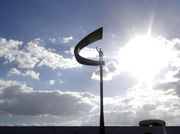
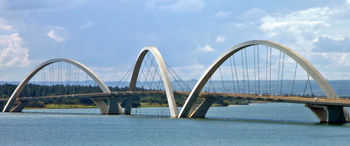
The Presidente Juscelino Kubitschek International Airport of Brasília and the Juscelino Kubitschek bridge were named after him. There is also a luxurious hotel named Kubitschek Plaza located in that city.
Many cities have things named after him, "JK" is a ubiquitous acroynm honoring the ex president, who is often seen by Brazilians as the "father of modern Brazil".
Descendants
In 1980, his daughter Márcia (1942–2000) married Cuban-American ballet star Fernando Bujones. Márcia Kubitschek was elected to the National Congress of Brazil in 1987 and served as lieutenant governor of the Brazilian Federal District from 1991 to 1994.
See also
- 1964 Brazilian coup d'état
- History of Brazil (1945-1964)
Notes
- ↑ Juscelino Kubitschek (1902-1976)
- ↑ Relaçőes bilaterais entre a República Theca e a República Federativa do Brasil (Bilateral relations between the Czech Republic and the Federative Republic of Brazil) (Portuguese)
- ↑ Brasil examina su pasado represivo en la Operación Cóndor, El Mostrador, May 11, 2000
- ↑ Operación Cóndor: presión de Brizola sobre la Argentina, El Clarín, May 6, 2000
References
- Alexander, Robert J. Juscelino Kubitschek and the Development of Brazil. Athens, Ohio: Ohio University Center for International Studies, 1991. ISBN 0-89680-163-2
- Bojunga, Cláudio. JK: o artista do impossível. Rio de Janeiro: Editora Objetiva, 2001. ISBN 85-7302-407-0 (Portuguese)
External links
- "The Man from Minas". Time Magazine. February 13, 1956. http://www.time.com/time/magazine/article/0,9171,893381-4,00.html.
| Political offices | ||
|---|---|---|
| Preceded by José Oswaldo de Araújo |
Mayor of Belo Horizonte 1940–1945 |
Succeeded by João Gusman Júnior |
| Preceded by Milton Soares Campos |
Governor of Minas Gerais 1951–1955 |
Succeeded by Clóvis Salgado da Gama |
| Preceded by Nereu de Oliveira Ramos |
President of Brazil 1956 – 1961 |
Succeeded by Jânio Quadros |
|
|||||||||||||||||||
|
|||||||
